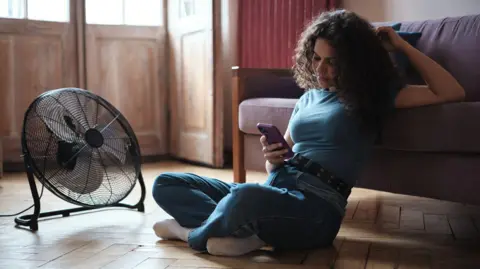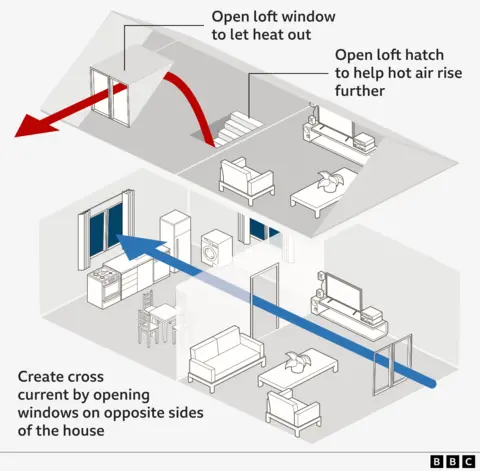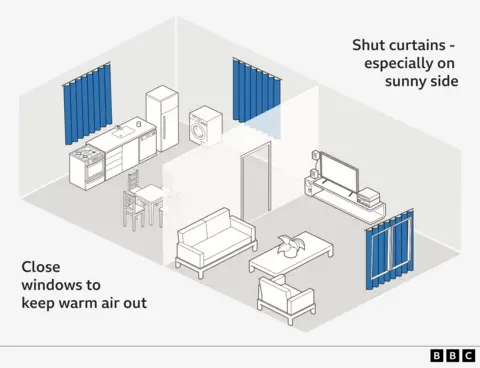Six ways to keep your home and yourself cool in hot weather
 Getty Images
Getty ImagesWhen temperatures soar, here are six simple things you can do to keep your home and yourself cool.
1. Let in cool air and encourage air flow
Open windows on opposite sides of the house to encourage air flow - releasing trapped warm air and allowing in cooler air.
Do this when the air temperature outside is cooler than inside, which tends to be overnight or in the early part of the day.

In flats which have windows on one side only, open doors and use a fan to encourage airflow.
Hot air rises within houses, so if you have loft vents or windows you can open them to release some of the heat.
The hot air can otherwise get trapped on the second floor, where you may be trying to sleep.
Extra insulation can also help keep heat out in the summer, as well as reducing your energy bills and usage in the winter.
2. Keep warmer air out during the day
In the heat of the day it is best to keep your windows shut and blinds or curtains closed - especially on the side of your home where the sun is shining.

3. Use a fan to enhance the breeze
Fans are a relatively cheap and energy efficient way to keep air moving and can help you stay cool.
Using a freestanding fan for a 24-hour period typically costs between 15p and 31p, according to the latest guidance from the Energy Saving Trust.
Putting the fan in front of an open window can encourage the fresh air from outside to be blown throughout the room - as long as it is cooler outside.
Placing ice cubes in front of the fan can cool the air being blown in your direction. You can use more than one fan to create a cross current.

Prof Mike Tipton of the University of Portsmouth says it is important to understand how the body works.
"Fanning the face improves thermal comfort most, but fanning the whole body helps lower body temperature more," he says.
But he warns that using a fan when temperatures are above 35C may make things worse, as you are ultimately just directing hot air towards your body.
Air conditioning is a much more expensive option than using fans. The Energy Saving Trust says 24 hours of continuous use costs between £4.84 – £6.
4. Limit hot activities
Ovens and cookers emit a lot of heat into the home during and after their use.
Sticking to cold foods such as salads - especially during the hottest times of the day - can stop unnecessary heat being generated.
Other appliances, such as washing machines and dishwashers, can also produce heat so try not to use them when it is hottest.
Heat exhaustion can also be brought on by high humidity - moisture in the air - so it is worth reducing humidity levels by:
- taking shorter and colder showers
- wiping excess water from surfaces
- moving indoor plants outside

5. Cool yourself down
Tepid showers can help to cool your body temperature, saving both money and energy. But Prof Tipton warns not to go too cold: "The trick is to try and get the skin as cool as possible whilst maintaining maximum blood flow to it.
"Too cold and the body will shut down blood to the skin and trap the heat in the body making it harder to get out."
Putting an ice pack or cold-water bottle on your body can achieve an instant feeling of relief. You may want to wrap it in a towel to avoid direct contact with your skin.
Your clothes can also really affect your body temperature.
Natural fibres like cotton and linen help to regulate body temperature and loose-fitting clothing allows room for the breeze to cool you down.
This is also why cotton bed sheets can help you sleep when hot air fills a room.

6. Find an alternative space
Air-conditioned public buildings such as libraries, leisure centres and shopping centres can also provide relief if your home is too hot.
Some local authorities have created a network of so-called "cool spaces" where the public can go, including London, Manchester and Bristol.
